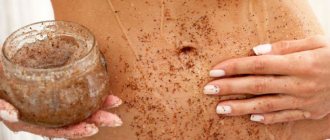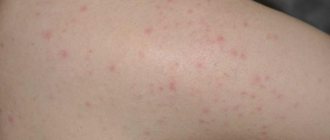Areas with small nodules are called follicular hyperkeratosis. According to various sources, from 4% to 34% of people have this feature, and according to the British Skin Foundation, even more: up to 40% of adults and 50-70% of teenagers.
In winter, the skin on the legs is drier, and the tops of these nodules turn red. Sometimes, especially after contact with tights, it resembles a rash, but with the beginning of spring, the redness and dryness disappear.
If the manifestations of follicular hyperkeratosis do not bother you, there is no need to treat it. But if the appearance of your skin or symptoms like dryness are causing you discomfort, there are a few tips that can help.
What is follicular hyperkeratosis and what areas of the skin does it affect?
Follicular hyperkeratosis, or goose bumps, is a fairly common skin condition in the form of a rash that occurs in early childhood or adolescence. It has a characteristic seasonality: in winter the rash worsens, and in summer it becomes almost invisible.
Manifestations of follicular hyperkeratosis are caused by the fact that dead skin cells in the form of scales fill the hair follicles and form characteristic “plugs”. As a result, small nodules form on the skin of the shoulders, front of the thighs, cheeks and buttocks. Very often, the skin around the nodules is prone to dryness, irritation and redness.
Vitamin complexes to combat the problem
To compensate for the lack of vitamins, it is not always enough just to add fresh vegetables and fruits to the diet. However, they are truly useful only during the season, and this period in Russia is 3-4 months a year. Therefore, when deciding how to get rid of goose bumps on the legs and other parts of the body, you should pay attention to special products - vitamin and mineral complexes.
They must contain the previously mentioned vitamins:
- A
– helps prevent keratinization of the epidermis; - C
– participates in the production of collagen, therefore, helps improve the structure of the skin; - D
– has a positive effect on the state of the vascular system, which delivers blood with nutrients to the skin tissues; - E
- helps strengthen cell membranes, but at the same time make them permeable to beneficial substances.
Natural coconut oil 100%, 100 ml, Raysan
589 ₽
Dietary supplement NOT A MEDICINE
What causes this condition
Source here and below: Pexels
The exact causes are still unknown, but heredity plays a significant role in the occurrence of follicular hyperkeratosis. Almost half of the patients had a relative with similar skin manifestations.
Allergy sufferers and atopics are more prone to follicular hyperkeratosis. This is also largely due to heredity.
Exercises to smooth out wrinkles
Now there is propaganda of face-building as the best remedy against wrinkles. But this is far from the best technique, quite the contrary. One of the reasons why wrinkles appear is muscle spasms. And through Facebook building you will only intensify these spasms. This means that new creases appear.
But there are special exercises that are aimed at relieving spasms and smoothing the skin. You can learn about them at advanced intensive courses from Melannette. By the way, there you will work not only the area around the eyes, but also the entire face - you will get rid of the eyebrows, deep wrinkles on the forehead, nasolabial and jowls. You will tighten the oval of your face and the corners of your lips, and lift your drooping eyelid. With regular practice, you will look several years younger.
Do people with follicular hyperkeratosis need to be under the supervision of a dermatologist?
Not necessary. If the manifestations of follicular hyperkeratosis do not bother you, there is no need to treat it. It is safe for human health.
What causes patients to seek help from a dermatologist is the appearance of the rash, dryness, and itching of the skin. The doctor’s task is to explain what follicular hyperkeratosis is, give advice on how to care for the skin at home,, if necessary, help select products and, in case of severe manifestations, prescribe additional treatment in the form of medicated creams. But sometimes proper home care may be enough.
Diagnostics
Basic examination methods:
- External examination of the affected area (skin with pimples, discoloration noted) and history taking.
- Palpation of the hyperkeratosis zone.
- Scraping and histological examination to exclude other diseases.
- UBC, OAM, blood for biochemistry and hormones.
The diagnosis is made by a dermatologist.
Additionally, consultation with a gastroenterologist or endocrinologist is indicated.
How to care for goose bumps
To reduce the manifestations of follicular hyperkeratosis, constant and long-term care is required. If a person stops taking care of the skin, the rash quickly returns to its previous state.
When caring for skin with follicular hyperkeratosis, it is important to prevent dryness and pay attention to hydration. You should refrain from using rough scrubs, washcloths, regular bar soap - anything that can cause irritation and dryness.
It is recommended to take a non-hot, warm shower for a maximum of 10 minutes. For gentle cleansing, you can use products created specifically for the care of dry atopic skin. After each bathing, it is recommended to immediately apply cream to damp skin.
Emollients are also suitable for dry atopic skin. Sometimes a cream with urea (containing 10-20%), salicylic and AHA acids may be a more effective option.
Additionally, toners and non-aggressive home peels with these acids can be used once or twice a week, but it is important to be careful not to cause excessive dryness of the skin. To achieve optimal hydration and exfoliation of the skin, you can combine these products.
Salon procedures can also reduce the visibility of skin rashes: acid peels, microdermabrasion, laser and light treatments.
For severe manifestations of follicular hyperkeratosis, it is better to consult a dermatologist. He will help you adjust your home care and, if necessary, prescribe medicated retinoid-based creams and creams to reduce inflammation of the rash.
Atopic dermatitis in children
Children's bodies are susceptible to many diseases, and one of the most common is atopic dermatitis. This inflammatory disease is allergic in nature and chronic in nature. Atopic dermatitis in children is expressed in peeling of the skin and itching, and is treated by an allergist.
What is atopic dermatitis?
This is a pathology of the epidermis, which is characterized by chronic immune inflammation. According to statistics, approximately every fifth child in the world experiences symptoms of atopic dermatitis. Most often, foci of inflammation develop in the area of the cheeks and folds, as well as in the area under the diaper.
The disease is characterized by a pronounced allergic nature and is associated with manifestations of immune dysfunction, which include food allergies, rhinitis, conjunctivitis, etc.
Lack of proper treatment can result in the development of severe forms of the disease. Also, neglect of qualified help threatens atopic march - a condition in which the disease “marches” throughout the baby’s body. This aggravates existing diseases and provokes the emergence of new ones. Contrary to misconceptions, atopic dermatitis in children does not go away with age.
Symptoms of atopic dermatitis in children
Symptoms of the disease depend on age. In this case, three phases are distinguished: infant, child and adult. The following symptoms are characteristic of each phase:
- symmetrical inflammation and redness
- dry skin that cannot be eliminated with cream
- severe itching causing discomfort
The disease has a direct connection with dysfunction of the epidermis. It is characterized by alternating periods of exacerbation with remissions. And, as a rule, in winter the situation worsens, and with the onset of the warm season, improvement is observed.
Stages of atopic dermatitis in children
There are two stages of the disease in accordance with the nature of the course, namely:
- acute - the skin becomes covered with rough red spots and papules, and crusts also appear, swelling is observed
- chronic - pigmentation on the skin of the eyelids increases, cracks form on the palms and soles, which is accompanied by thickening of the skin.
Causes of the disease
Dermatitis has a hereditary predisposition, and the main factor in its occurrence is genetic. If the parents have suffered from the disease, the probability of it developing in the child is about 80%.
In addition, the following causes that affect the mother’s body and fetal development can trigger the appearance of atopic dermatitis:
- unbalanced diet
- exposure to toxic substances
- infectious diseases
- regular stress
Children who have suffered oxygen deprivation or were born prematurely are also especially susceptible to atopic dermatitis.
Diagnosis and treatment of atopic dermatitis
Diagnosis can only be made by a dermatologist. As part of the examination, the specialist prescribes blood tests (general and biochemistry), urine analysis, skin biopsy, etc. In accordance with the research results, an individual treatment plan is prescribed.
Nutrition and vitamins for youthful skin
Health, and therefore beauty, depends on our nutrition. No amount of cosmetics will help hide imperfections on your face if you eat just anything.
Strict restrictions affect the supply of vitamins necessary for the body. Therefore, if you suddenly decide that it’s time to go on a strict diet, it’s better not to do it. Proper nutrition should become a part of life, and not periods of “enlightenment”.
So what vitamins and microelements do humans need and what foods contain them?
| Element | What does it contain? | Why is it needed? |
| Protein | Eggs, legumes, pumpkin seeds, nuts. | Chief for construction in the body. Necessary for the synthesis of collagen, which is responsible for the elasticity of the skin. |
| Fatty acid | Fish, flax seeds, olive oil, nuts. | Participate in the synthesis of lipids, which slow down the aging process. |
| Cellulose | Beans, pumpkin, broccoli, buckwheat, bananas, tomatoes. | Absorbs and removes toxic substances from the body. |
| Melanin | Cherry, corn, rice. | Responsible for pigmentation. |
| Beta carotene | Carrots, paprika, lettuce, beets. | Natural antioxidant. Evens out skin tone and protects against premature aging. |
| Vitamin A | Broccoli, pumpkin, peas. | Increases skin elasticity by participating in collagen synthesis. |
| B vitamins | Potatoes, cauliflower, spinach, eggs. | Necessary for normal lipid and protein metabolism in the skin. |
| Vitamin C | Citrus fruits, kiwi, strawberries, sea buckthorn. | Another powerful antioxidant. Participates in collagen synthesis. |
| Vitamin E | Pine nuts, sea buckthorn, cabbage, peas. | Combats dryness and slows down the appearance of wrinkles. |
| Biotin | Eggs, beets, cabbage, mushrooms. | Makes skin radiant and healthy by dilating blood vessels. |
| Zinc | Buckwheat, wheat, beans, peanuts. | Regulates the functioning of the sebaceous glands, prevents the formation of inflammatory processes. |
| Calcium | Sesame seeds, dates, shrimp, cabbage, beans. | Participates in the synthesis of structural elements of the skin. |
Massage to reduce wrinkles under the eyes
The best technique for getting rid of wrinkles is massage. In order to do it, you don’t have to go to a professional; you can do it yourself at home.
Massage helps relax cramped muscles, accelerates blood flow and improves cell nutrition.
There are many massage options and in the video you can see one of them:
- Press the pads of your index fingers tightly together on the bridge of your nose;
- Run your fingers from the bridge of your nose to the inner corners of your eyes. Repeat the movements for a minute;
- Now find the bones under your eyes. Using patting movements, moving from them to the temples. Also a minute.
Do this exercise now and do it daily. It won't take much time, but it will give a good effect. And for better results, sign up for advanced intensive courses.










